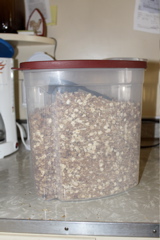Back when we first moved in, we had some out-of-control bushes creating a hedge between our yard and the neighbors'.
Anyway, Keith cut down all the bushes while donning a full-body pair of painter's coveralls to keep safe from poison ivy. We had learned the hard way while removing some other bushes that there was a lot of poison ivy hiding in there and we both ended up going to the doctor for steroid shots because we had it so bad. Early in the spring, our friend Jamie came by with his truck and helped Keith get all the roots pulled out. Then that stretch became a multi-purpose mess: dumping ground for compost material when our bin got full, volunteer pumpkin patch, woodpile for the fire pit.
We owe the neighbors an apology. It wasn't pretty. Not at all. Thankfully, they are pretty easy-going people who don't spend a whole lot of time in their yard and therefore, didn't spend a whole lot of time looking at that eyesore.
What, you might ask, is our plan for this forgotten and neglected sliver of the quarter-acre? What an excellent question! Our ambitious and long-term plan is espalier apple trees. And yes, I mispronounce espalier every single time I say it. Sometime, way down the line, this is what our living apple fence could look like:
The above picture and most of what we know about this endeavour come from this helpful website.
We began this project by cleaning up and leveling off the area where we wanted to put in posts and trees. I say "we" but really I mean Keith.
Then we put in stakes for where the posts would go, spaced ten feet apart. This part I did help with.
Then Keith took a break. A well-deserved one.
We went to Lowe's and bought five posts and some quick-setting concrete to put around them and then Keith got to work digging holes. While digging the first hole, he quickly realized we were going to have to change the position of the fence a bit because where we wanted the first post was precisely where an outhouse once stood (sat?) and there was some kind of foundation buried down there. So we relocated a bit and he was back in business. No, not outhouse kind of business. Hole-digging business.
He made the holes about 18" deep. Then we set the posts in and Keith mixed and poured concrete while I obsessively checked the posts with a level to be sure they were straight and measured the water needed for the next batch of concrete.
After the concrete set up, Keith went back and put some caulk around the top to help keep moisture from getting next to the wood.
Our next step will be to string wire between the posts to train the tree branches on. Which brings me to our next issue: trees. Over the weekend, we hit up a couple local nurseries looking for four small trees suitable for our project. We need two different varieties of trees for pollination purposes, and they have to be young trees with no branches or very small, flexible branches, also known as "whips" according to the website listed above. At each nursery, we were told they do not sell trees that small. After hearing this answer several times, Keith and I looked at each other and voiced the same question: If you sell big trees, don't they start as little trees? And why can't we buy them when they're little? It's like Dunkin Donuts selling medium and large vanilla chai but not a small. But hey, that's a whole other story.
So, much as we would have liked to buy trees from one of the places around here and already have them planted at this point, our plan was foiled. We went online and found a company that sells young trees. I even called them and asked if the trees were a suitable size to train on a fence, to which the kind customer service rep Barbara replied, "That's what we call 'espalier' and they'll work just fine." I certainly wasn't about to butcher that word while talking to a tree expert. At any rate, the trees are on order and due to ship in early November. We would have liked to plant them sooner, but according to the lady at one of the nurseries, as long as the ground hasn't frozen, it's ok to plant trees. In the meantime, we will work on getting our wire up and putting some edging around the tree area so it won't require mowing between the trees and posts. Eventually, we'll probably plant some flowers and mulch the area as well.
And that is the post about posts. We'll keep you posted (I really can't help myself) when we have some more progress on this project.



















































